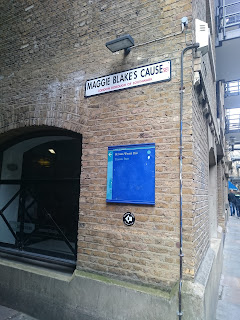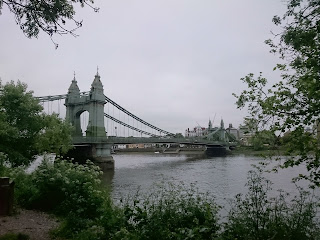 We had decided, some time ago, that our objective was the Thames Barrier, i.e. the most obvious point to differentiate river and sea, and the end of the original Thames Path National Trail, not its more recent short extension. So this was our last leg, and we were accompanied by family members to mark the occasion. As this walk wound around the Isle of Dogs (but on the south bank), the new buildings of Canary Wharf seemed to be constantly with us.
We had decided, some time ago, that our objective was the Thames Barrier, i.e. the most obvious point to differentiate river and sea, and the end of the original Thames Path National Trail, not its more recent short extension. So this was our last leg, and we were accompanied by family members to mark the occasion. As this walk wound around the Isle of Dogs (but on the south bank), the new buildings of Canary Wharf seemed to be constantly with us.  The walk from Rotherhithe continued mostly along the shoreline, past former dock and industrial areas now mostly used for housing, and with the river now opening out. Nelson House (pictured) is on one of the short stretches where the path has to duck inland round a block of buildings. Our first stop was at the Surrey Docks Farm, with its artfully designed steel gates. This is indeed, as the guidebook says, "delightful", and was busy with children and families when we called in for refreshment and a toilet break.
The walk from Rotherhithe continued mostly along the shoreline, past former dock and industrial areas now mostly used for housing, and with the river now opening out. Nelson House (pictured) is on one of the short stretches where the path has to duck inland round a block of buildings. Our first stop was at the Surrey Docks Farm, with its artfully designed steel gates. This is indeed, as the guidebook says, "delightful", and was busy with children and families when we called in for refreshment and a toilet break.  As we first saw Greenwich in the distance, what appeared to be blocks of flats turned out, on closer inspection, to be a cruise ship. This became clearer as we approached and made it out, eventually,as 'The World'. Approaching Greenwich itself, the path regrettably wanders away from the riverside through Pepys Park and then some backstreets. A new footbridge across Deptford Creek, not in our guidebook, takes the path back towards the frontage as we approached the Cutty Sark and tourist hotspot of Greenwich. The tide was very high as we walked around the front of the Royal Naval College, waves splashing onto the narrow path.
As we first saw Greenwich in the distance, what appeared to be blocks of flats turned out, on closer inspection, to be a cruise ship. This became clearer as we approached and made it out, eventually,as 'The World'. Approaching Greenwich itself, the path regrettably wanders away from the riverside through Pepys Park and then some backstreets. A new footbridge across Deptford Creek, not in our guidebook, takes the path back towards the frontage as we approached the Cutty Sark and tourist hotspot of Greenwich. The tide was very high as we walked around the front of the Royal Naval College, waves splashing onto the narrow path. We stopped for Sunday lunch at the Trafalgar Tavern. Food was good enough but surroundings a little pretentious. After this, signage on the Thames Path became a little confusing, the prospect of a short cut across the North Greenwich peninsula making our destination appear closer than it was for taking the long way round. We continued past some still-open industrial wharves, then a massive golf range, towards the Dome. The Greenwich Peninsula Ecology Park is a nice little spot right on the path (and, for us, another toilet break).
We stopped for Sunday lunch at the Trafalgar Tavern. Food was good enough but surroundings a little pretentious. After this, signage on the Thames Path became a little confusing, the prospect of a short cut across the North Greenwich peninsula making our destination appear closer than it was for taking the long way round. We continued past some still-open industrial wharves, then a massive golf range, towards the Dome. The Greenwich Peninsula Ecology Park is a nice little spot right on the path (and, for us, another toilet break).
Soon, we began to approach our destination. Looking back, we could see the towers of London and the Emirates cable car link that we had earlier passed under.
Here, the end of the Thames Path is formally marked, and the length of the Path represented in a mural in concrete. We didn't call at the barrier visitor centre.
A little forward planning meant I had bought a bottle of champagne at Champagne & Fromage in Greenwich (such opportunities to purchase not obviously available at the barrier). We celebrated our completion of the Thames Path.




















